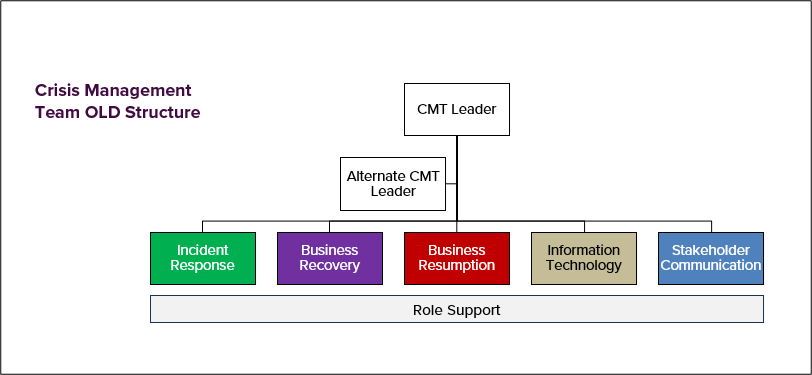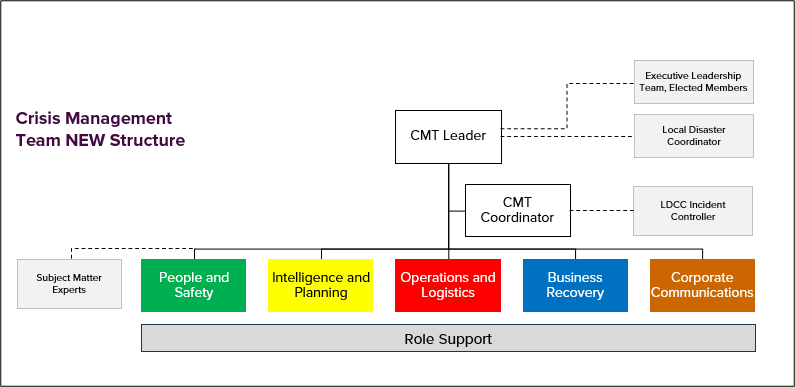At a glance
- Highlighted gaps: Outdated plans, limited training and structural misalignment.
- Organisation: Logan City Council
- Collaboration: Worked extensively with Phoenix Resilience to co-design and validate the new Crisis Management Team (CMT) structure
- Key findings:
- Integrated structures improve response: Aligning the Crisis Management Team (CMT) with the Local Disaster Coordination Centre (LDCC) and Australasian Inter-Service Incident Management System (AIIMS) enhances coordination and clarity.
- Dynamic planning is essential: Activation triggers and scenario-based exercises are more effective than static plans.
- Shared responsibility drives resilience: Embedding crisis readiness across teams reduces reliance on discretionary effort and improves sustainability.
- Sector relevance: Integrated crisis management, shared responsibility, continuous improvement.
Introduction
Prior to the COVID-19 pandemic, business continuity planning at Logan City Council was managed by a small group of staff within the Risk Management and Insurance Program. This responsibility was not their primary role, and planning relied heavily on static documents, including a 98-page Master Business Continuity Plan (Master BCP) and six directorate recovery plans. These documents were not utilised during the pandemic response, revealing a critical gap in practical and adaptive crisis management.
This case study explores how Logan City Council evolved its crisis management structures to better align with contemporary emergency response needs, particularly through the integration of business continuity and disaster management functions.
Methodology
Internal audits and training reviews identified that Council’s business continuity plans had not been updated for more than three years and no longer reflected the current organisational structure. In response, a targeted initiative was launched to address the audit findings and incorporate feedback from training sessions.
A key focus was the structure and function of the Crisis Management Team (CMT). Initial efforts to revise the CMT structure were met with resistance. To facilitate change, Phoenix Resilience was engaged to conduct a targeted exercise with the CMT, guided by the Australian Institute for Disaster Resilience principles on exercise management. This approach enabled team members to critically assess the effectiveness of the existing structure and identify opportunities for improvement from their own perspective.
Insights from the exercise were combined with established disaster management practices and the LDCC Framework, which operates under the AIIMS model. This ensured the revised structure was fit for purpose and aligned with recognised principles of interoperability, role clarity and consistent operational language.
Discussion of results
The CMT desktop exercise was a pivotal moment in identifying structural inefficiencies and opportunities for improvement. Phoenix Resilience played a critical role in shaping these outcomes, providing strategic advice and practical frameworks that informed the new CMT model.
Key outcomes included:
- Simplification of activation protocols
- Proactive posture alignment with LDCC
- Structural redesign with new functional roles and a CMT Coordinator (similar to an Incident Controller)
- Interoperability with LDCC and AIIMS
- Validation through training and the 2024 Exercise Series
- Real-world application during ex-Tropical Cyclone Alfred
During the exercise, the team critically assessed the existing CMT framework and recommended substantial changes. A key finding was that the activation matrix within the master Business Continuity Plan (BCP) was overly complex and prescriptive. In response, the team proposed a simplified set of activation triggers aligned with disaster management practices, enabling more timely and risk-informed decision-making.
The exercise also underscored the importance of a proactive posture for the CMT. It was agreed that when the LDCC transitions to 'stand up' status, the CMT should shift to 'lean forward'—gathering intelligence and assessing impacts on council infrastructure, services, and staff. This recommendation informed the development of a new crisis management and business continuity plan, replacing the outdated Master BCP and directorate recovery plans.
Based on feedback from the exercise, a revised CMT structure was implemented. Key enhancements included the introduction of functional roles such as People and Safety, Intelligence and Planning, and Business Recovery, along with the appointment of a dedicated CMT Coordinator to strengthen leadership and coordination. The new structure mirrors the LDCC framework and adopts the AIIMS model, ensuring interoperability and consistent operational language.


To validate the revised structure and planning approach, a comprehensive training program was developed. It focused on cell-based collaboration, situational awareness, dynamic risk assessment, and mental health support. The program culminated in the 2024 Exercise Series, which simulated a Southeast Queensland-wide power outage as a result of a cyberattack on the power grid. This was the first simultaneous activation of both the CMT and LDCC, demonstrating the benefits of an integrated approach. The CMT concentrated on organisational impacts and risks, while the LDCC managed community consequences. The exercise highlighted strong collaboration, proactive thinking, and the need for improved resource allocation and information sharing.
The evolution of the CMT structure reinforced the value of clear roles, streamlined communication, and integrated planning. Practitioners benefit from a shared operating picture, reduced duplication and enhanced resource coordination. The effectiveness of the new model was confirmed during the response to Ex-Tropical Cyclone Alfred, where the revised structure supported a unified and agile crisis response.
Conclusion
This case study supports a shift toward integrated and collaborative crisis management. The revised CMT structure demonstrates the value of aligning business continuity and disaster management functions to enhance preparedness and enable rapid, coordinated responses.
By embedding interoperability into policy and practice, the new model fosters consistency, clarity, and resilience across council operations. It reduces pressure on LDCC functions during disaster events and strengthens the organisation’s capacity to recover services efficiently.
This evolution reflects the sector-wide principle of shared responsibility, where crisis preparedness and response are not confined to a single team but are distributed across interconnected functions. The alignment with the AIIMS and LDCC frameworks ensures a common operating language and facilitates seamless collaboration during complex events.
In the spirit of continuous improvement, the next steps include:
- Trialling a coordinated exercise week involving all groups using a common scenario.
- Conducting After Action Reviews (AARs) to refine protocols, resources, and decision-making processes.
- Enhancing shared situational awareness tools to support real-time intelligence and coordination.
- Increasing organisational awareness of the distinct but complementary roles of the CMT and LDCC.
- Establishing clear, scalable protocols for CMT activation and communication.
This case study reinforces the importance of adaptive leadership, integrated planning, and a culture of learning and principles essential for building disaster resilience across Queensland’s disaster management sector.
Questions?
Please email all questions to Sherry Paterson, Business Continuity Coordinator, City of Logan, SherryPaterson@logan.qld.gov.au



